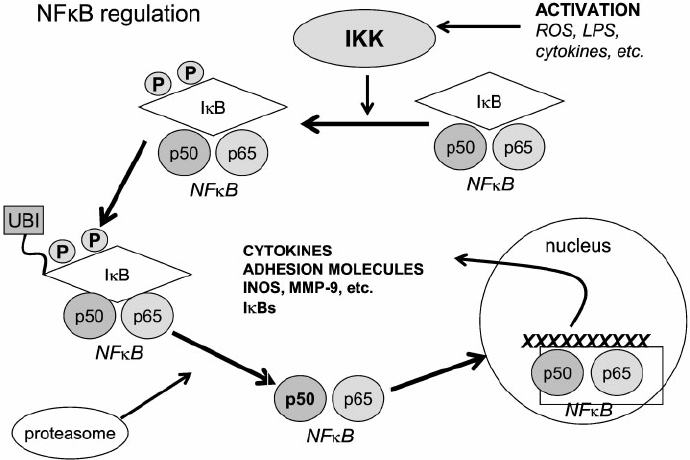กก
กก
Post-ischemic inflammation: molecular mechanisms and therapeutic implications
กก
A model illustrating the signaling pathway of NFkB activation. NFkB, shown here as a heterodimer consisting of p65 and p50 subunits, regulates expression of a number of inflammatory genes. IKK is activated following brain ischemia, causing the phosphorylation of its inhibitor protein, IkB. IkB is phosphorylated by its corresponding kinase (IKK) leading to ubiquitination (ubi) and degradation in proteasomes. This causes the dissociation of NFkB from IkB. Liberated NFkB then translocates into the nucleus, turning on the transcription of its downstream target genes, IKK 5 IkB kinase
กก
Post-ischemic inflammation: molecular mechanisms and therapeutic implications
Zhen Zheng & Midori A. Yenari
Pages 884-892 | Published online: 19 Jul 2013Department of Neuroscience, School of Medicine, Standord University
Abstract
Ischemic stroke is characterized by the disruption of cerebral blood flow (CBF). This reduction of CBF results in energy failure and secondary biochemical disturbances, eliciting a robust in situ inflammatory response.Post-ischemic inflammation is a dynamic process involving a complicated set of interactions among various inflammatory cells and molecules. The resident inflammatory brain cells, microglia, are especially activated in response to ischemic insults, many of which are regulated by nuclear transcription factor, kappa B (NF-kB).
As a result, several inflammatory genes are expressed, leading to local generation of various cytokines, which in turn promulgate inflammatory signals. Meanwhile, endothelial cells lining the local cerebral blood vessels are stimulated to produce adhesion molecules, causing the migration of peripheral circulating leukocytes into the compromised brain tissue, an event that amplifies inflammatory signaling cascades.
Post-ischemic inflammation appears to serve multiple purposes, depending on its timing and magnitude, as well as the topographic distribution of various inflammatory molecules. Data from experimental manipulations of some inflammatory molecules are yielding insight into therapeutic strategies for ischemic stroke.
This review focuses on some recent advances regarding the regulation of inflammatory signaling pathways, the detrimental effects of post-ischemic inflammation and the potential molecular targets for ischemic stroke therapy.
Post-ischemic inflammation: molecular mechanisms and therapeutic implications: Neurological Research: Vol 26, No 8
https://www.tandfonline.com/doi/abs/10.1179/016164104X2357
